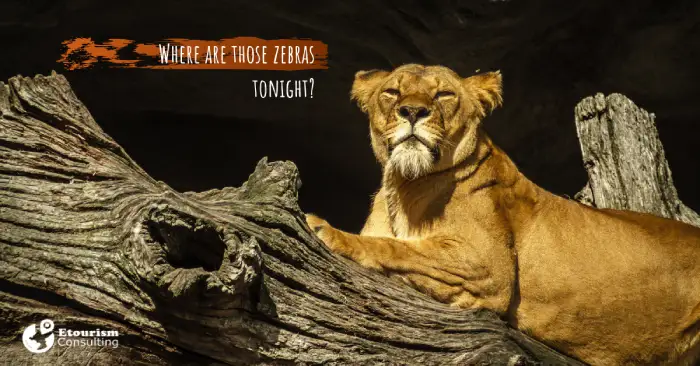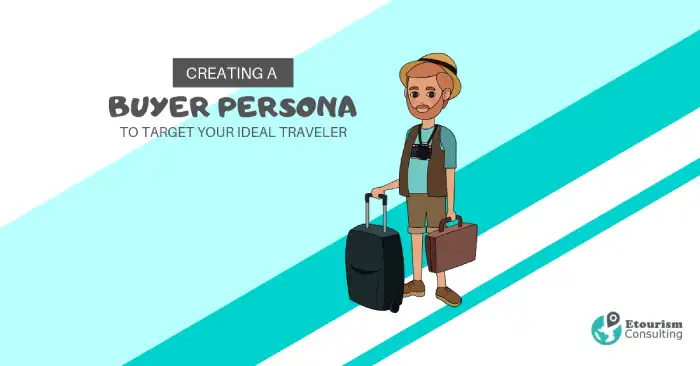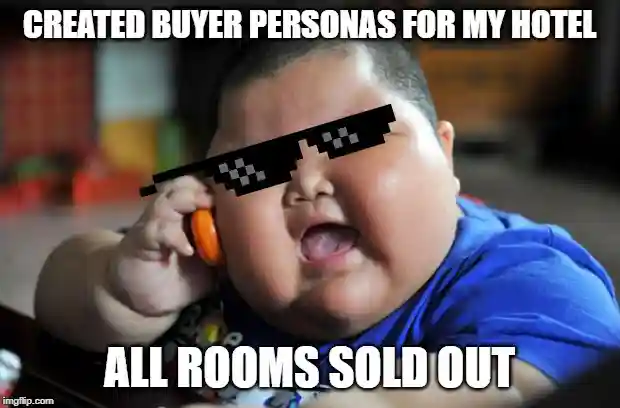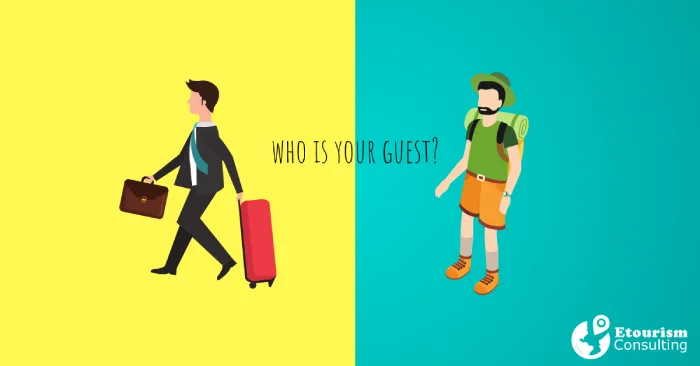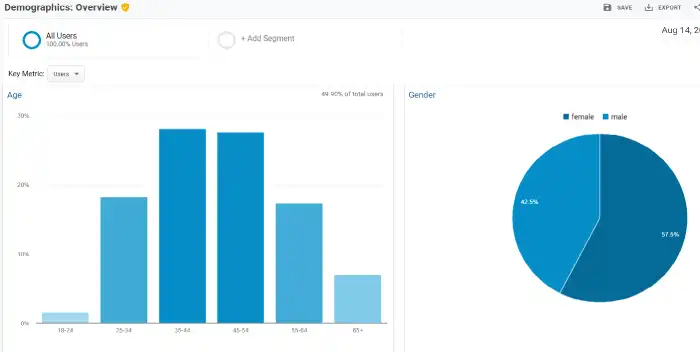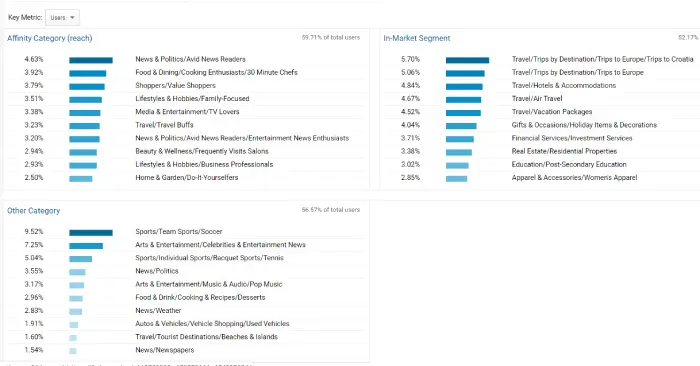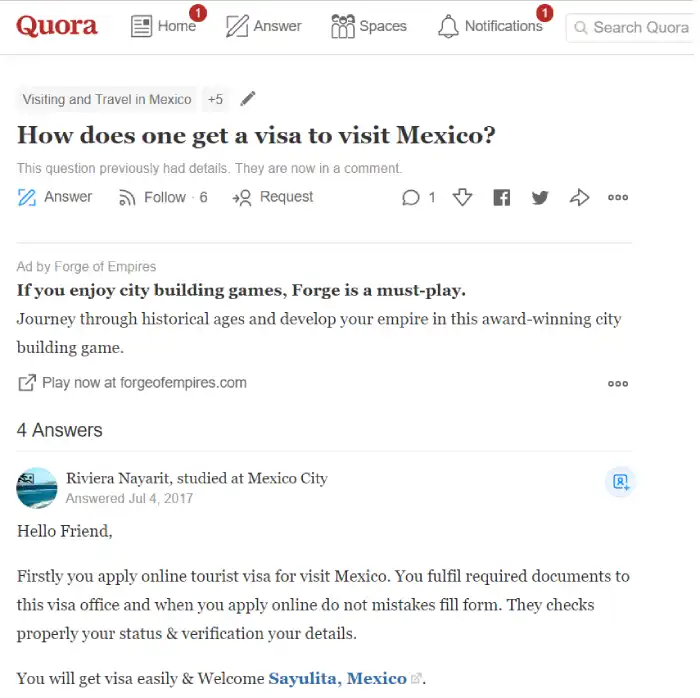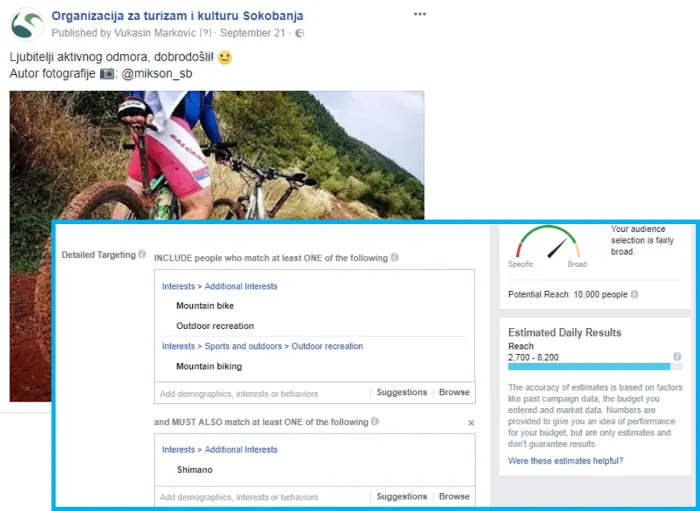A “Buyer Persona” is defined as the semi fictive representation of your ideal customer, based on market research and data about your actual customers.
One thing is certain – this method will allow you to customize your promotional messages to different market segments and maximize your marketing efforts!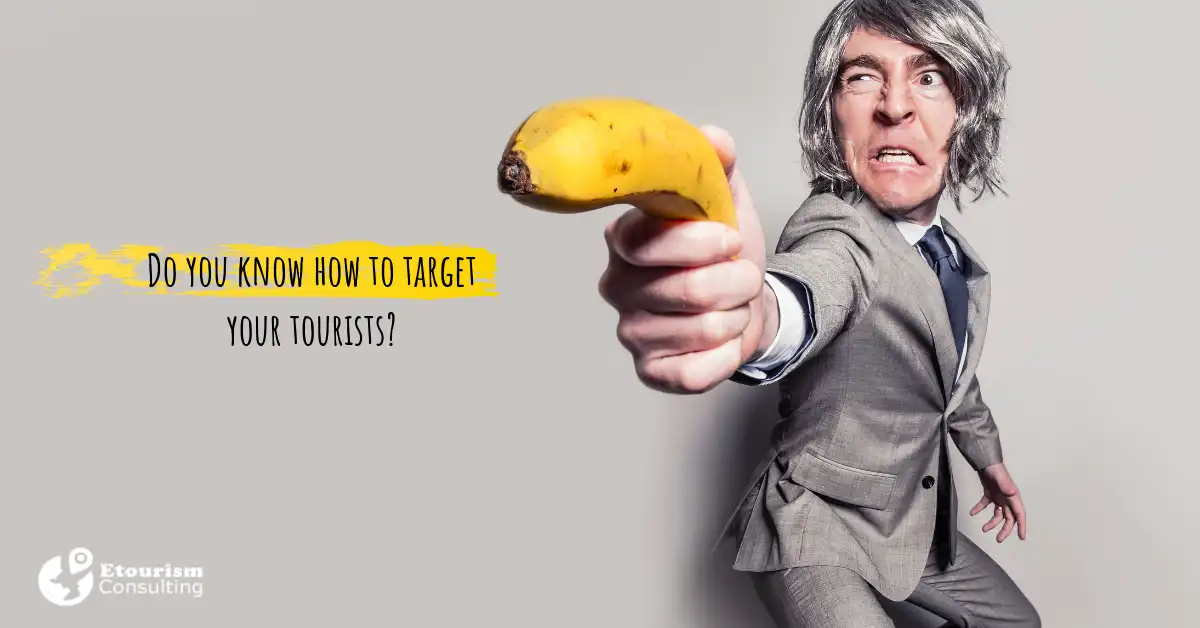
If you are working in travel marketing, then you certainly already know that audience targeting is one of the strongest weapons you have in your marketing arsenal. However, in order to be able to perform appropriate targeting, you need to know who your “target” is.
We often emphasize that today, personalization is the key to success in tourism. Not only that you need to personalize your service but also your promotions and sale messages. The first step on this path is to create a so-called buyer persona.
Have you asked yourself who are your ideal guests and what problems can you solve for them?
If you do not have a clear picture of who your potential guests or tourists are, there are great chances that you will invest a lot of effort and resources in marketing and that in the end, you will not achieve the desired results.
In other words, all your marketing efforts and tactics have to be directed to the right people to those who are your potential tourists.
If you do not know how to recognize them and do not understand their habits, needs, desires, opportunities, and problems, your marketing performance will not yield any results; no matter how hard you try, simply because it is aimed at the wrong audience.
Lions can’t hunt zebras if they don’t know how they move, what are their needs and weaknesses.
The same applies to your marketing ads if you don’t know where and how to attack your ideal travelers.
Therefore, knowledge and understanding of your potential guests is a prerequisite for achieving desirable marketing results.
Why is this important?
The Internet has brought incredible possibilities in targeting, or displaying ads exactly to those people who are interested in what we offer.
Previously, there were no such options. You could have put a beer advertisement at the time of the football game, but you’re not sure whether only beer lovers will see it and how many among them do not drink beer.
Now, however, you can easily show your ad ONLY to those people who are interested in what you offer and pay just for that. Therefore, the Internet is the most effective marketing channel, but only if you promote the offer to people who are your target group.
To know how to take advantage of this, you must first do the homework and get to know your target group.
If you don’t do that you will go to your Facebook Ads or Google Ads platform and you won’t know how to set up your targeting, or you will do it wrong. It is therefore important that you read this article.
What is A “Buyer Persona“?
A “Buyer Persona” is defined as the semi fictive representation of your ideal customer, based on market research and data about your actual customers.
We know that we cannot be devoted to each individual (potential) tourist and guest, so long as their number is higher. Similarly, we cannot offer the same product or service to all our customers, primarily because their interests are different – the diversity of demand, as one of the main features of the tourism market, also conditions the relative diversity of the offer.
We know that in tourism, the offer is not easily adapted to a tourist demand. If a tourist is looking for a pool, you cannot make it overnight; if a guest demands a larger bathroom, you cannot just expand it. It is, therefore, important that you focus your bid on the market segment that you think will be most interested in what you offer.
What we can do is group a large number of our individual clients around some common interests, needs, problems, and so on. Just here, the “Buyer Persona” enters the scene.
After analyzing who our potential tourists are, we can segment them according to their needs, desires, interests, based on gender and age, family status, purchasing power, and so on.
Based on this analysis and market segmentation, different groups of our potential clients can be individualized in the form of one, two or three “Buyer Personas”.
As we have already said, “Buyer Persona” is a half-fictional figure of our ideal client. Why is it half-fictional? Because this person does not actually exist, we have invented and created it on the basis of numerous information and data about our real clients.
“Buyer Persona”, or our ideal client, represents a kind of generalization of all the characteristics of a particular target group. It is an ideal representative of one of our target groups (you should not have more than 5 target groups on the market).
Instead of focusing on some abstract concepts such as your target market or target group, “Buyer Persona” allows you to “humanize” and individuate your promotional messages.
Simply, you will easily understand your clients if you can “point your finger” to them and name them by one name, instead of talking about them using pronouns.
Based on all of the above mentioned, it’s clear that “Buyer Persona” will help you send a clearer and customized message to your target group, keeping your advertising costs low, which will ultimately result in more effective marketing.
How to create a Buyer Persona?
First of all, consider how your “ideal guest looks:
- How many years she has?
- What is her job and how much she can pay for a trip?
- Does she travel alone or with her family?
- Does she needs parking or transfer from the airport
- What is she generally interested in?
- Can she have an active vacation in your destination?
- Does she speak your language?
These are all the details that you, more or less, already know about the existing and potential tourists and guests. The closer and more precise you do that, the better the “Buyer Persona” will be.
To create your “Buyer Persona” you need to understand that group of your potential tourists and guests and see what their common characteristics are, if they have some common problems, fears hopes, and finally, their basic needs and wishes which you can fulfill with your offer.
There are several ways to do this…
GOOGLE ANALYTICS
By reviewing reports in the “Audience” section of your Google Analytics, you can learn a lot about your audience.
Demographic reports show the age and gender of your website’s visitors, and also the info about location and language, which devices are used (desktop, laptop or mobile).
Probably the most useful segmentation of your audience is based on their interests.
For each of these segments, check what their behavior on the website is – how long they stay, how many pages they turn during one visit, and what is the bounce rate. Those who have the greatest retention time, a higher number of pages visited per session and a smaller bounce rate are definitely candidates for sorting them into different buckets and defining them as buyer personas.
FACEBOOK ANALYTICS
Facebook page of your travel agency, destination, restaurant or a hotel also collects a wealth of information about your followers. This information is very useful because it helps you to better understand the fans of your page.
You can get even more info in the Facebook ads analytics. Just go to your ads manager, use the Breakdown option and choose between ages, gender, location, devices, etc.
You can definitely learn a lot about demographics of the people who engaged with your Facebook page or some of your ads.
What’s also important to emphasize is that the data contained in Google Analytics and on the Facebook page do not apply to the same audience! Audience information in Google Analytics relate to the visitors to your website, while the data in your Facebook page statistics relate to your Facebook page’s followers and fans.
FACEBOOK GROUPS
Facebook groups most often gather people of the same interest, with the same occupation, problem or any topic discussed by its members. All you have to do is search for the groups that deal with travel, hotel, tourism, specific destination, etc.
There you can see which questions are the ones that the members of the group are often troubled with, which topics bring the most interests, what they are afraid of and what their previous experiences were (either positive or negative).
Additionally, you can look at their personal profiles to get an approximate picture of who these people are, gathered around the common interest (e.g. Italy travelers, mountain lovers, nightlife enthusiasts), which is the essence of creating a “Buyer persona”.
ONLINE FORUMS
Similarly to Facebook groups, you can follow discussions on forums about important issues and questions related and important to your business.
Questions like “How to get a visa for Mexico?” or “What is the maximum size and weight of luggage?” and the responses can help you understand the fears and concerns of your potential tourists.
REVIEWS
These are the real experiences and critics at the expense of your business and the quality of service provided by your tour company, restaurant, destination or hotel.
Browse the book of impressions; see the reviews that your hotel’s guests have left on the websites such as Booking.com or Tripadvisor, see the reviews that fans leave on your Facebook page – you will see what your tourists and guests liked and disliked. Knowing your existing customers will definitely help you profiling your “Buyer Persona”.
TALK TO YOUR POTENTIAL TOURISTS
Every time a potential tourist enters your agency, sends an email or leaves a message on your hotel’s page, try to find out more about him and his needs. Do you have a specific destination in the offer, whether your hotel is “pet-friendly”, whether vegetarian food is on the menu of your restaurant, whether it is a family holiday resort, does your hotel have a wheelchair ramp?
Starting from some of the most common questions and needs, to specific requests – you can learn a lot about your potential guests and tourists just by talking and communicating with them.
Additional tips
Think carefully about the details, because sometimes certain small things can be groundbreaking in high-quality targeting. Here are some examples…
Fears
You must know the true fears of your tourists. For example, parents with young children always fear for their safety, so in the ad you create, you can write that a doctor will accompany the group during the trip.
What do the tourists really want?
Do you know what your visitors really hope for and what exactly, perhaps secretly, they want from your hotel? If you recognize that, you are lucky! You can read more about this in this article.
Favorite websites
Where do your guests spend most of their online time? What are the websites and applications? Here you should not generalize and say something like “sports websites” or “babysitting and parenting websites”, but state the specific domain names of those websites. You can use this later in many ways, but the most obvious is to target these websites as placements with your ads using the Google Ads Display campaign.
Favorite brands
Sometimes, only one brand is enough to laser target the specific group and execute the most effective campaigns. For example, mountaineers probably liked McKinley’s brand, photographers liked Nikon, Sony, Cannon, or Carl Zeiss. You can easily reach the cyclists by targeting those who have demonstrated an interest in Shimano brand, with additional constraints on other interests (biking, mountain biking, etc.).
Here’s how we did it for the Sokobanja Tourist Organization:
Free template for creating the Buyer Persona
If you have come to the end of this article it means that you have recognized the importance of creating a “Buyer Persona”.
That’s why we have prepared this template for you to help you create your “Buyer Persona” more easily for travel agencies, tour companies, travel destinations, hotels, apartments, restaurants, and other industry stakeholders.
Do the necessary research of the market, potential tourists and guests, and use this template to create your “Buyer Persona”!
Let’s mention once again that it is possible to create more than one “Buyer Persona”. Depending on how complex and heterogeneous your potential clients and guests are, you can create two, three or more “Buyers Personas” (we do not recommend more than five).
For example, for the marketing strategy of a hotel or apartment, two “Buyers Personas” could be created – one for the domestic, the other for the foreign guests, one for business, the other for leisure tourists or one for young couples, and the other for families with children.
Destination management organizations could also profile two “Buyer personas” the same way.
Travel agencies should make the segmentation for each package individually but also generally at the agency level.
Finally, we also note that just creating your “Buyer personas” does not guarantee great results.
Yes, in most cases it will help you achieve better marketing results, but it is necessary to say that there is no guarantee for it. However, much depends on the way you have explored and collected information about your potential tourists and guests, how you will execute the campaigns and on many other things.
One thing is certain – this method will allow you to customize your promotional messages to different market segments:
- You will show an ad to your business guests in which you will say that you have conference rooms, laundry services, photocopier and, excellent WiFi.
- You will show an ad to families with children in which you will emphasize that you have a playroom for children, a children’s menu in a restaurant, and an animator that will give parents the opportunity to have a few hours for themselves (because that’s what they secretly want).
Two completely different advertisements and one hotel. That’s personalization!
Get started from creating a “Buyer persona”, and if you need help, feel free to contact us.

